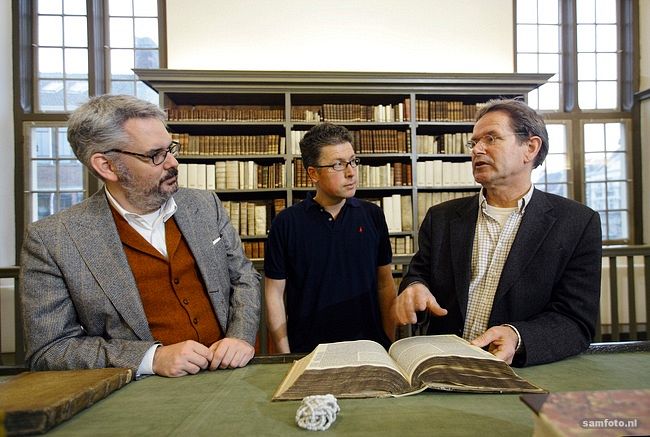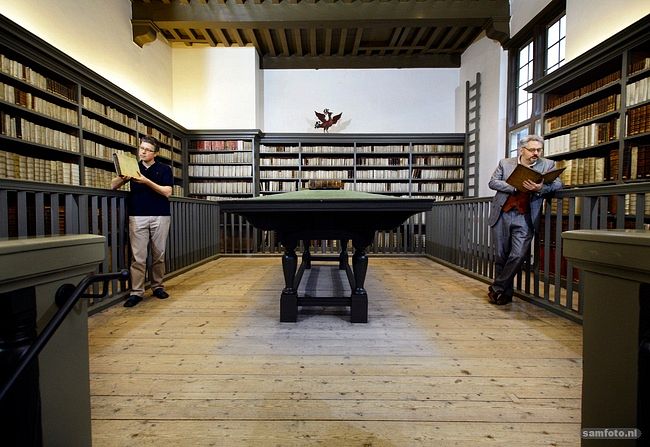Hidden in the covers of 16th-century books are innumerable pieces of parchment adorned with medieval texts. Material researcher Joris Dik and book historian Erik Kwakkel use X-rays to uncover this camouflaged medieval library. ‘We’re digging for treasure’.
With everything from liturgical works to court reports and dictionaries, the repository of Leiden University Library is home to a motley collection of literature. The age of the works varies enormously, from early 16th century to modern day. This is the field of activity of book historian Dr Erik Kwakkel. ‘It’s a delight to come here and browse through the enormous range of works’, says Kwakkel while showing us around.
But the researcher isn’t overly concerned with the actual books stored here, rather in what’s hidden in their spines. ‘Aha, look. France, 12th century. This is great’, he suddenly calls out enthusiastically. He’s caught sight of the spine of a Latin dictionary, printed in Basel in 1573. The cover has been damaged, revealing the underlying piece of parchment added by the bookbinder to add strength.
‘XPI’ is among the text on the parchment, written in exquisite, curled handwriting. ‘That means Christ, abbreviated in Latin. This piece of parchment was probably from a liturgical work’, concludes Kwakkel. ‘The first half of the twelfth century’, he adds upon closer inspection. ‘How I can tell?’ Kwakkel chuckles. It turns out that there’s not exactly an easy answer.
‘You can see the letters ‘d’ and ‘e’ overlapping slightly. That’s indicative of the period’. But this evidence doesn’t provide conclusive proof, determining the age of books also relies on an element of intuition. ‘Dating books is a bit like tasting wine’.
‘Sua non habere‘, reads Kwakkel aloud. He’s accessed the Google Books website on his smartphone, and types in the words. It’s possible that, after the art of printing was developed, the original book from which he has now found a small fragment was reprinted. And that centuries later, this reprinted edition was scanned into Google Books’ enormous database. If so, Kwakkel can precisely trace the fragment that he’s discovered.
Unfortunately, his search doesn’t get any hits. ‘By playing with the words, I can usually find out which book the fragment is from. You have to get a bit creative’.
Whatever book it was, the binder cut up the medieval work in the 16th century and used it to strengthen his own books. Isn’t that a bit barbaric? Perhaps. But after the advent of book printing, binders recycled hand-written medieval manuscripts as a matter of course. The covers of 16th and 17th-century books thus conceal a veritable medieval library. By pushing the damaged spine of this book a little to the side, Kwakkel lifts a corner of the metaphorical veil.
We continue the tour of the repository. But at a snail’s pace – from all over the place, damaged book spines are making eyes at us. ‘Whether it’s in a library or an antiques store, I always keep my eyes open for old fragments’, says the book historian. ‘It’s addictive. I haven’t yet discovered anything older than the 12th century, that’s what I hope to find someday’.
X-rays
And he may not have to hope for too much longer. Kwakkel has teamed up with material researcher Prof Joris Dik from the Faculty of 3mE (Mechanical, Maritime and Materials Engineering). Dik shot to fame with his work on X-raying paintings. Several years ago, his team developed the macro-scanning X-ray fluorescence spectrometry (MA-XRF) technique to detect concealed layers of paint in works by the Dutch Masters (see textbox ‘Searching for the hidden layers’).
The technique has also proved successful for the visualisation of concealed medieval ink. Dik and Kwakkel spent the last three months of 2015 scanning spines of books in Leiden University Library. They tested various set-ups to not only identify hidden texts, but primarily to also make them legible.
Kwakkel isn’t able to demonstrate the process now. The equipment has been returned to the Rijksmuseum, where Joris Dik is once again using it to investigate paintings.
The two researchers have successfully unravelled a total of 20 texts and back in his office, Kwakkel shows off a few of their special finds. He summons up a 12th-century page on his computer monitor, featuring a text by the early medieval English scholar Beda (written in 735 AD). He also shows a text fragment dating to approximately 1400 from a Dutch book of hours (a collection of prayers said at set times of the day or week), from the hand of monastic reformer Geert Grote.
A long-cherished dream
It was a long-cherished dream of Kwakkel to not only have to rely on damaged books, but to be able to X-ray all books; to quickly scan larger chunks of text. The subject came up when he was talking to Dik, whom he knew from The Young Academy (they are both members). ‘At airports, they scan everything with X-rays. Can’t we just take a pile of books to Amsterdam Airport Schiphol?’, he pondered. If only it were that simple. But Dik did like the idea. In 2014, The Young Academy accepted their subsidy application, awarding funds destined to support innovative interdisciplinary research.
‘Our experiments have now proved that macro-scanning X-ray fluorescence spectrometry works’, says Dik. ‘But making the texts legible is a hell of a job. Last year, we were really groping in the dark. We didn’t know how deep in the parchment we should focus, or the duration of exposure. We didn’t even know how to configure the bundle: do you aim at a large area, or zoom in on a specific, smaller section? To stay with photography terminology: we didn’t know if we should be using a wide angle or a telephoto lens. But we ended up with some good images in the end. We sometimes left the scanner running for an entire weekend. And we’d come back into the library on Monday morning and a medieval text would be awaiting us on the monitor attached to the equipment’.
‘Texts are more difficult than paintings’, continues Dik. ‘Unscrambling these medieval texts is really fiddly work. Just try distinguishing an ‘i’ from an ‘e’ – the images have to be extremely high definition. But when the text appears, and you can actually read it, that’s certainly really exciting’.
Miniature synchrotron
The pair now want to further develop the technology to enable them to scan much faster. With the current macro-scanning X-ray fluorescence spectrometry equipment, they use an X-ray tube. ‘This tube creates a bundle of just 30 watts’, explains Dik. ‘It’s like taking a photograph by light from a tea light candle’. We’d like to purchase a miniature synchrotron – a mini particle accelerator. That can make bundles a thousand to ten thousand times stronger. That would allow us to scan a thousand to ten thousand times quicker’.
‘But you can’t take a machine like that with you just like that. They’re about the size of a small car. It will be about another five years before we’re ready. In the meantime, we’ll carry on working with the X-ray tube and we’ll experiment with techniques that we’ll potentially also be able to use later with the synchrotron’.
Dik hopes to eventually be able to scan through leather book covers as well, instead of only through paper and parchment as has been the case up until now. ‘The mini synchrotron would also enable us to investigate paintings quicker and more effectively’, adds Dik. ‘It would also allow us to look through metal. And there are a host of potential applications in the medical world’.
Up until now, it has also proved difficult to decipher pages with writing on both sides, because the letters on each side of the parchment blend in with each other. ‘If we’re able to produce sufficiently clear images, we should be able to use image analysis software to separate the two texts’, says the Delft professor.
‘We’ve scanned 20 books in three months, but that’s merely just a drop in the literary ocean. We think that approximately a quarter of the books are hiding medieval texts. A lot of that is liturgical, and that’s not very interesting. Those works were rewritten every 20 years. But a small number of books conceal something else. There are books that we know have existed. From references, we know that Wimmel, the author of Reynard the Fox, probably also wrote another major work called the Madoc. Imagine that we discover fragments of that book. I would like to progress to being able to scan 100 books a day. That’s when the dig for treasure will truly begin’.
The technology
Macro-scanning X-ray fluorescence spectrometry (MA-XRF) involves exposing objects to a thin bundle of X-rays. The X-rays pass through the parchment or the top layer of paint to the iron atoms in the centuries-old ink or the metallic atoms in the old paint pigment. These atoms become agitated, they enter a higher energetic state. But they quickly return to their original state, emitting radiation. Based on the wavelength of this radiation – the fluorescence – Joris Dik can determine the elemental composition of the object. He can therefore reveal the distribution of various elements under the surface of paintings, or bring the ferruginous ink used on old manuscripts to light.

Do you have a question or comment about this article?
tomas.vandijk@tudelft.nl


Comments are closed.